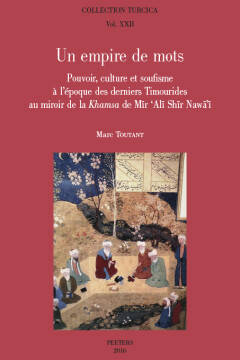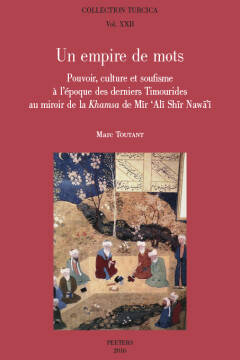
- Afhalen na 1 uur in een winkel met voorraad
- Gratis thuislevering in België vanaf € 30
- Ruim aanbod met 7 miljoen producten
- Afhalen na 1 uur in een winkel met voorraad
- Gratis thuislevering in België vanaf € 30
- Ruim aanbod met 7 miljoen producten
Zoeken
Un empire de mots
Pouvoir, culture et soufisme à l'époque des derniers Timourides au miroir de la Khamsa de Mir 'Ali Shir Nawa'i
M. Toutant
€ 86,00
+ 172 punten
Omschrijving
English summary: Although Tamerlane's heirs were not able to preserve the territorial extension of the empire they inherited, the Timurid century, which followed the conqueror's death, has been regarded as one of an authentic Renaissance of arts and culture. At his court, the last great Timurid ruler Sultan Husayn Bayqara could pride himself on having such talented artists as the miniaturist Bihzad and the poet Jami. There was yet another figure who has long remained unknown in the West and who made his mark on this time more than any other did. The statesman, patron and writer Mir 'Ali Shir Nawa'i (1441-1501) authored numerous works in Eastern Turkish, and was already considered to be the greatest representative of Chaghatay Turkish literature which, thanks to him, reached its apogee. The study of his works, and especially his masterpiece called Khamsa - an imitation of Nizami Ganjawi's famous pentalogy - is fundamental for many reasons. In addition to being an embodiment of the aesthetics of the period and a reflection of the dynasty's aspirations just before the Timurids were eclipsed, it also marked the first attempt to forge a distinctive Turkish speaking culture within a Central Asian world dominated by Persian civilisation. French description: Si les successeurs de Tamerlan n'ont pu conserver l'extension territoriale de l'empire qui leur avait ete legue, le siecle timouride quia suivi la mort du conquerant est connu comme celui d'une veritable renaissance de la culture et des arts. La cour du dernier grand souverain timouride, Sultan Husayn Bayqara, pouvait en effet s'enorgueillir de cultiver le genie d'artistes tels que le miniaturiste Bihzad et le poete Jami. Mais il est une autre figure qui reste largement meconnue en Occident et qui a pourtant plus qu'aucune autre marque de son empreinte cette epoque. Il s'agit de l'homme d'Etat, mecene et litterateur Mir 'Ali Shir Nawa'i (1441-1501), dont l'oeuvre volumineuse composee pour partie en turc oriental a donne ses lettres de noblesse a la litterature turque centrasiatique. L'etude de cette oeuvre, et notamment de l'une de ses pieces majeures, la Khamsa composee sur le modele de la celebre pentalogie de Nizami Ganjawi, est fondamentale a plus d'un titre. Non contente d'incarner pleinement la specificite esthetique de cette periode et de refleter les aspirations d'une dynastie a la veille de sa disparition, elle marque en outre la premiere tentative de forger une culture turcophone specifique dans une Asie centrale alors dominee par la civilisation persane.
Specificaties
Betrokkenen
- Auteur(s):
- Uitgeverij:
Inhoud
- Aantal bladzijden:
- 701
- Taal:
- Frans
- Reeks:
- Reeksnummer:
- nr. 22
Eigenschappen
- Productcode (EAN):
- 9789042932173
- Verschijningsdatum:
- 31/12/2016
- Uitvoering:
- Paperback
- Formaat:
- Trade paperback (VS)
- Afmetingen:
- 160 mm x 239 mm
- Gewicht:
- 1319 g

Alleen bij Standaard Boekhandel
+ 172 punten op je klantenkaart van Standaard Boekhandel
Beoordelingen
We publiceren alleen reviews die voldoen aan de voorwaarden voor reviews. Bekijk onze voorwaarden voor reviews.








